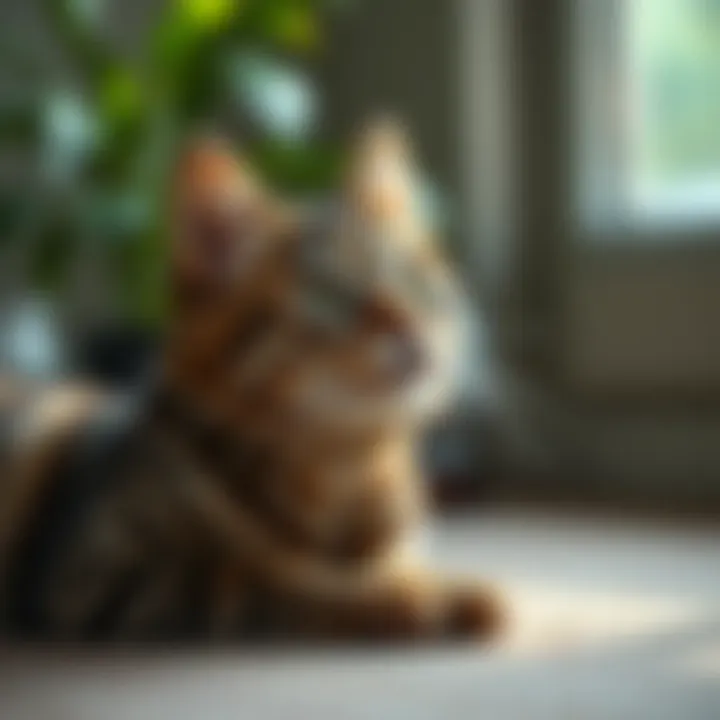Proven Methods to Eliminate Cat Urine Odor


Intro
Pet ownership, while immensely rewarding, comes with its own set of challenges. One of the less glamorous aspects of having a feline companion is the unpleasant odor that can arise from cat urine. Understanding how to effectively tackle this issue not only enhances the living environment for everyone in the household but also contributes to the well-being of the pet. In this comprehensive guide, we will explore a variety of solutions for removing cat urine odor, delving into the causes behind the smell and offering practical tips for prevention and maintenance.
When a cat feels the desire to mark its territory, it produces urine that can leave behind an assertive scent. This odor is not merely bothersome; it can linger long after the initial incident, making it necessary for pet owners to take significant action. The challenge lies in recognizing that traditional cleaning solutions may fall short when addressing this specific problem. By exploring both time-honored and innovative cleaning strategies, the aim here is to equip cat owners with the knowledge they need to reclaim a fresh and inviting space.
Pet Care Essentials
Daily Care for Cats
Understanding your pet’s needs serves as a foundation for effective odor management. A well-fed and nurtured cat is more likely to behave in desirable ways. This includes regular feeding, which fuels not just their body but also their spirit. A balanced diet, rich in nutrients, can keep your cat healthy and limit issues that may lead to unwanted urination indoors.
Proper nutrition directly influences your cat's behavior and health, reducing stubborn marking tendencies.
- Nutrition Requirements
- High-quality protein sources for muscle health.
- Adequate hydration, especially if feeding dry kibble.
- Supplements if necessary, but consult with a vet first.
Exercise and Activity
Engagement through exercise and play is essential. A bored cat may resort to marking their territory out of frustration or anxiety. Regular playtime strengthens the bond between you and your feline, while also providing physical and mental stimulation. Encourage interactive play with toys that mimic natural hunting behavior. This not only keeps your cat fit but also diverts their attention from potentially destructive behaviors.
Grooming and Hygiene
Grooming is another critical aspect of care. While it might not directly correlate to urine odor, it plays a role in overall hygiene. Regular brushing reduces shedding and aids in keeping the litter box area clean. Both can contribute to a more pleasant indoor atmosphere.
Health and Wellness Check-ins
Lastly, regular veterinary check-ups are vital. A healthy cat is less likely to experience behavioral issues, including unwanted urination. Keep an eye out for any changes in litter box habits, as these may signal underlying health issues. If you notice something off, a quick trip to the vet can be invaluable.
By laying a solid foundation of daily care, you not only foster a positive environment for your cat but also mitigate the chances of those stubborn urine odors taking root in your home.
Intro to Cat Urine Problems
Dealing with cat urine odor is a common hurdle for cat owners, one that can quickly spiral into a frustrating saga if not handled correctly. Recognizing the significance of this issue is crucial not just for a clean home, but also for the overall well-being of both feline and human companions. Understanding the root causes of these olfactory offenses can pave the way for effective solutions, turning a distressing challenge into a manageable situation.
Understanding Cat Urine Composition
To tackle the unpleasant effects of cat urine, it’s necessary to take a closer look at its composition. Cat urine isn't just a simple liquid; it contains a blend of urea, creatinine, uric acid, and various proteins, each of which contributes to the daunting odor. Among these, the presence of ammonia is notable, especially since, in concentrated forms, the smell can become overwhelmingly pungent.
Additionally, cats possess a remarkable ability to concentrate urine to conserve water. This adaptation, while beneficial from a hydration standpoint, can lead to even stronger odors when accidents occur. The unique chemistry of cat urine means that merely covering the odor with scented sprays or air fresheners often falls flat, as these attempts merely mask the issue rather than eliminate it.
Why Cat Urine Produces Strong Odor
Understanding why cat urine carries such a strong scent is essential for effective remediation. One key factor is the high protein diet that many domestic cats thrive on, which contributes to the compound called skatole, known for its intense smell. This can be particularly troublesome in households where multiple cats reside, leading to a cocktail of odors that can be hard to control.
Moreover, when cat urine saturates soft materials such as carpets or upholstery, the odor tends to linger due to its tendency to bond with fabrics. Even after the initial mess is cleaned, residual compounds may remain deep within the fibers, reasserting their presence every time the area is disturbed.
"A clean home is not just a want; it’s a necessity for both human and feline residents, particularly when dealing with such potent scents."
It’s worth noting that the strength of the smell can also be exacerbated by certain environmental factors, such as temperature and humidity. Wet conditions can amplify the odor, while higher temperatures can lead to quicker decomposition of organic compounds within the urine, releasing unpleasant fragrances into the air. Thus, by addressing the underlying chemistry and environmental influences, pet owners can take significant steps toward ensuring a fresher and healthier living environment.
Identifying Affected Areas
When it comes to tackling the problem of cat urine odor, the first step is to pinpoint where the trouble spots are. Identifying affected areas is crucial for an effective cleanup strategy. If you miss even one small puddle of cat urine, it can continue to stink up the joint. Therefore, understanding where your feline friend likes to do their business can save you a whole heap of trouble down the road.
The importance of this section cannot be understated. Regular cleaning and maintenance of areas affected by cat urine not only keeps your home smelling pleasant, but it also promotes better health for both pets and humans. It’s all interconnected! A thorough investigation can prevent lingering odors from becoming a recurring issue, confirming that your living space remains a comfortable haven.
Common Surfaces Affected by Cat Urine
In households with cats, several surfaces are commonly affected by urine stains and odors. These include:


- Carpets and Rugs: Soft surfaces absorb liquids like a sponge, making them prime suspects for containing cat urine.
- Wood Floors: If left untreated, cat urine can seep into floorboards, resulting in both an odor and permanent damage.
- Tiles and Grout: While tiles might seem easy to clean, grout can absorb urine and odors, creating a persistent problem.
- Couches and Upholstery: Cats sometimes target furniture, especially if they feel their scent is lacking in certain areas.
Understanding these surfaces helps pet owners be more vigilant. For example, if you have a particular carpet or rug, you might want to use pet-specific cleaning products or consider a pet odor neutralizer to make sure you eradicate all traces of urine.
Signs of Cat Urine Presence
Knowing how to identify the signs of cat urine presence can be a game-changer. Sometimes, the smells can be subtle, but other times they can hit you like a freight train! Here are some signs to watch out for:
- Strong Ammonia Smell: If you notice a pungent ammonia-like odor, it’s a surefire indicator that cat urine is somewhere nearby.
- Discolored Spots: Look for yellowish stains on carpets, floors, or walls. They usually indicate where a cat has relieved themselves.
- Wetness: Freshness counts, so if a surface feels damp and smells bad, you might have a urine issue.
- Behavioral Changes in Cats: If your cat starts acting strangely or marking more than usual, these could be signals they feel compelled to establish territory.
The bottom line is that missing these signs can lead to heightened stress levels for both you and your pet. The earlier you can identify and act on an odor problem, the easier it is to remedy. By being aware of where and how your cat behaves, you arm yourself with information you'll need to keep your living space clean and odor-free.
"The best way to deal with cat urine odor is to act quickly and thoroughly—don’t let it settle in."
With these insights, you should feel better prepared to tackle cat urine odors head-on, ensuring a happier home for everyone involved.
Immediate Actions to Take
When it comes to tackling the unpleasant smell of cat urine, swift action is not just advisable—it’s essential. Cat urine can seep into various materials and surfaces, making it a stubborn problem if not addressed promptly. Immediate actions can minimize the risk of long-lasting odor and potential damage to your home. This section will highlight the importance of quick, effective response strategies to alleviate the lingering effects of cat urine.
Steps for Emergency Cleanup
Upon discovering cat urine, you’ll want to kick things into high gear. Here’s a structured approach to perform emergency cleanup:
- Blot, Don’t Rub: Use paper towels or an absorbent cloth. Gently blot the area to soak up excess urine. Rubbing can spread the stain wider and may push it deeper into the material.
- Cold Water Rinse: After blotting, pour a small amount of cold water onto the affected area. This helps dilute the urine and reduces the concentration of the odor.
- Repeat Blotting: Use fresh absorbent material to blot the area again, absorbing the diluted solution.
- Select a Cleaning Solution: At this stage, you can apply a cleaning solution—using a mixture like vinegar and water (1:1 ratio) or a commercial enzymatic cleaner can work wonders.
- Let it Sit: Allow the solution to sit for at least 10-15 minutes. This time allows the cleaning agents to break down the odor-causing compounds.
- Final Rinse: Use clean water to rinse the area again, and then blot up any excess moisture.
- Dry the Area: If possible, use a fan or open windows to encourage drying. A well-ventilated area will help dissipate lingering odors.
These steps may seem straightforward, yet they are critical in preventing odors from embedding deeply in carpets, fabrics, or wooden surfaces. Remember, the faster you act, the less chance there is for the odor to become entrenched in your living space.
Importance of Quick Response
The single most important factor in managing cat urine odors is how quickly you can respond. Delays can lead to a few unfortunate outcomes. Immediate attention can prevent cat urine from settling deep into your carpet fibers or porous surfaces, where it becomes almost impossible to remove entirely.
Moreover, delaying the cleanup process can attract other issues. Not only might the smell become worse, but your cat could also start returning to the same spot to mark territory once they realize that odor is still there. This behavior can evolve into a cycle that leads to even more cleaning woes. According to veterinarians and animal behaviorists, one of the critical aspects of pet ownership involves understanding and addressing your pet's needs and behaviors.
"Cleaning cat urine quickly is equally about maintaining the health of your relationship with your pet as much as it is about keeping your home fresh."
Fast action can also save you money in the long run. Casual mistreatment of certain furniture or flooring can lead to irreversible damage, necessitating replacements or intensive repairs. Equipping yourself with the right tools and knowledge will take you a long way. Thus, the message is clear: act fast and effectively to manage the situation; it’s worth every effort.
Traditional Cleaning Methods
When it comes to dealing with the stubborn scent of cat urine, traditional cleaning methods hold a special place. These techniques have been used for generations, not just because they can effectively tackle odors, but also due to their accessibility and overall approach to care for home environments. Using known household items can be particularly beneficial for pet owners who seek immediate solutions without the necessity to delve into commercial products that may contain harsh chemicals.
One of the key advantages of traditional methods is their familiarity. Many pet owners prefer solutions that they can create with a handful of ingredients commonly found in their kitchens. This familiarity can breed a certain level of comfort as well as reliability. Furthermore, these methods often come at a lower cost compared to commercial products, which is a practical consideration in households where cats may repeatedly create messes. Understanding some traditional cleaning solutions can empower owners to tackle odor issues proactively, ensuring their living spaces remain pleasant.
Salt and Water Solution
One effective traditional solution is the salt and water mixture. Salt has been known for its absorbent properties. To create this mix, combine about one cup of salt with one quart of warm water. This creates a solution that works wonders on absorbent surfaces such as carpets or upholstery. Once the mixture is ready, saturate the affected area generously with it.
After pouring the saltwater mixture, it’s important to allow it to sit for several hours—ideally overnight. This waiting period lets the salt draw moisture and odors out. Once the time has passed, simply blot the area with a clean cloth, following with rinsing and drying.
Considerations should be made for the types of fabrics you are treating because prolonged moisture may lead to mold growth if not adequately dried. Additionally, ensure to test on a small, inconspicuous area first to determine that the fabric or surface can tolerate salt without damage.
Vinegar and Baking Soda
Another popular cleaning method is the use of vinegar and baking soda. This dynamic duo works not just for cat urine, but can be effective for a variety of odors around the home. Start by sprinkling baking soda liberally on the affected area. Baking soda naturally absorbs odors—often likened to how a sponge soaks up water.
After you’ve allowed the baking soda to sit for about 10 minutes, it’s time to apply vinegar. Mix equal parts vinegar with water in a spray bottle, and spray it over the baking soda. You’ll notice it fizz and bubble; this reaction helps lift dirt and odors from the fabric or surface.
Once the fizzing subsides, let it sit for 5-10 minutes. Afterward, blot the area with a clean cloth or paper towel to absorb any remnants. Finish up by rinsing with clean water and ensuring the area is well-ventilated. It’s worth noting that while vinegar has strong deodorizing capabilities, its scent may linger briefly; however, it dissipates as it dries.
Ultimately, traditional cleaning methods rely heavily on nature’s simple ingredients, providing effective solutions in an approachable manner. These techniques not only help in cleaning up after our furry friends but can also cultivate a sense of resourcefulness in how we maintain our homes. For more insights and updates on pet care, check out Wikipedia on Household Cleaning.


Commercial Products for Odor Removal
When it comes to tackling the stubborn and pervasive smell of cat urine, commercial products often emerge as the first line of defense for many pet owners. These solutions are specially formulated to break down the components of cat urine, neutralizing the odors effectively and efficiently. It's no surprise that understanding the right products to choose can significantly affect both the cleaning process and your home environment.
Investing in the right commercial products can save time, reduce stress, and commonly lead to better results than homemade alternatives. It's crucial to consider a few critical elements before making a purchase:
- Efficacy: Look for products specifically designed for pet urine. Many general all-purpose cleaners may mask the smell but do not fully eliminate the underlying compounds causing the odor.
- Safety: Consider the safety of ingredients, particularly if you have children or other pets nearby. Non-toxic, biodegradable options are worth prioritizing for peace of mind.
- Ease of Use: Read instructions and reviews; some products may require longer dwell times or specific application methods that might not fit into your cleaning routine.
Enzymatic Cleaners
One of the most effective categories of commercial products are enzymatic cleaners. These cleaners contain enzymes that biologically break down the uric acid crystals found in cat urine. Traditional removing methods often fail because they might just cover up the scent without addressing the root cause — the urine itself. Enzymatic cleaners, however, attack the matter directly.
The key benefits of enzymatic cleaners include:
- Complete Breakdown: Unlike mere odor masking agents, these cleaners break down the urine into simpler, odorless components. This totally mitigates the chance of the smell coming back after some time.
- Multi-Surface Usage: Many enzymatic cleaners can be used on various surfaces, including carpets, hardwood floors, and fabrics. Just check the label to ensure compatibility with the specific material you're treating.
- Eliminating Stains: Not only do they tackle scent, but they also lift stains, making it a two-fer to enhance both the cleanliness and appearance of your space.
When using enzymatic cleaners, ensure to follow these tips:
- Test a small, inconspicuous area first to check for potential discoloration.
- Allow the cleaner to sit for the recommended time to maximize effectiveness, often at least 10-15 minutes.
Odor Neutralizers
Odor neutralizers work differently compared to enzymatic cleaners; they focus on masking or eliminating odor molecules rather than attacking urine’s molecular composition. These products include sprays and powders designed to neutralize smells instantly instead of requiring prolonged exposure to work.
Some notable features of odor neutralizers are:
- Instant Results: Odor neutralizers can provide an immediate sense of relief when unwanted scents hit the atmosphere. They're great for a quick fix.
- Variety of Forms: Available in sprays, granules, or air fresheners, you can easily tailor your approach depending on the area and severity of odor.
- Layered Approach: For the best results, they can be used in conjunction with enzymatic cleaners. This combo not only handles immediate smells but ensures the underlying problem is addressed as well.
A couple of practical tips when using odor neutralizers include:
- Ensure the area is sufficiently ventilated to allow for effective dispersal of the product.
- Reapply as needed, especially in high-traffic areas or after a cleanup.
Remember: It’s always a good idea to read product reviews and conduct research on the best commercial products available. Consider visiting PetMD for further information on specialized cleaning products suitable for pet owners.
By focusing on effective commercial solutions, you can create a more pleasant and hygienic living environment, keeping both your home and your furry friend happy.
Natural Alternatives to Chemical Cleaners
In the ongoing battle against cat urine odor, many pet owners find themselves seeking solutions that do not rely heavily on harsh chemicals. Exploring natural alternatives is not just better for the environment but can also be safer for your pets, children, and the overall home atmosphere. These solutions can effectively tackle the strong smell that cat urine leaves behind while minimizing exposure to synthetic ingredients that could potentially irritate the respiratory systems of both humans and pets alike.
When considering natural methods, it’s essential to understand that the effectiveness of cleaning solutions can widely vary based on the type of urine stain and surface. However, with a bit of experimentation and patience, you can discover what works best for your situation, leading to a fresher and more pleasant living environment. Here are some specific elements and benefits in adopting natural cleaners:
- Safety: Natural alternatives usually do not contain harmful chemicals. They are often biodegradable and less likely to cause skin irritations or respiratory problems.
- Cost-Effectiveness: Many items used in natural cleaning solutions, such as vinegar and baking soda, are relatively inexpensive and can often be found in your pantry.
- Environmental Impact: Using everyday kitchen items helps reduce your household’s carbon footprint while sending fewer pollutants into landfills.
Considerations about using natural alternatives should also be weighed. Not all natural cleaners are suitable for every material. For instance, using vinegar on certain natural stone surfaces could cause damage due to its acidic nature. Moreover, some natural ingredients may have a strong scent that does not appeal to everyone. Understanding these nuances will help you make informed decisions when combatting cat urine odors.
Essential Oils and Their Uses
Essential oils are a popular choice for those seeking a fragrant and effective method for eliminating cat urine smell. Oils like tea tree, lavender, and lemon possess natural antibacterial properties. Here’s a quick look at their uses:
- Tea Tree Oil: Known for its potent antimicrobial and antifungal qualities, tea tree oil can help neutralize odors and kill bacteria. However, care must be taken as some cats may be sensitive to this oil. It’s wise to use it in small amounts and ensure proper ventilation.
- Lavender Oil: This oil is often valued for its calming scent, which can help mask unpleasant odors. Lavender also has gentle antiseptic properties.
- Lemon Oil: Besides providing a refreshing scent, lemon oil can break down the ammonia components in cat urine, making it much easier to remove the smell.
To create an essential oil cleaner, simply mix a few drops of your chosen oil with water in a spray bottle. Spray it on the affected area and allow it to sit for a few minutes before blotting it up with a clean cloth.
Homemade Cleaning Solutions
Creating your own cleaning solutions can be as simple as using common household items. One of the simplest and most effective mixtures involves baking soda and vinegar. Here’s how it works:
- Start by blotting up any fresh urine with paper towels. The quicker you act, the better your chances of fully removing the odor.
- Sprinkle baking soda generously over the stained area. This will help absorb moisture and odor.
- Mix equal parts of white vinegar and water in a spray bottle and lightly spray over the baking soda. Expect some fizzing; this reaction helps neutralize odors.
- Let the mixture sit for about five to ten minutes, then blot with a clean cloth. You may want to vacuum up any remaining baking soda once it’s dried.
"Using natural alternatives not only addresses the specific odor issues but also aligns with a greener, healthier lifestyle."


Incorporating these natural approaches into your pet care regimen not only serves a practical purpose but also fosters a sense of responsibility toward the environment. Should challenges arise with cat urine odors, these environmentally friendly options are not just alternatives; they can be effective first-line defenses.
Preventing Future Incidents
Preventing future incidents of cat urine odor is crucial for a harmonious living environment for both you and your feline companion. Once you've tackled the immediate cleanup and eradicated existing odors, the real work begins. It is about forming habits and making adjustments that will help mitigate the chance of those pesky situations arising again. Not only does this promote a cleaner home, but it also ensures your pet feels secure and comfortable. After all, a happy cat makes for a happy home.
Adjusting Litter Box Practices
A well-maintained litter box is a cornerstone of cat hygiene. If a litter box is not appealing to a cat, they will likely seek alternatives, which could sadly be your carpet or other surfaces. Here are some ways to adjust your litter box practices:
- Choose the Right Size: Your litter box should be big enough for your cat to comfortably turn around and dig. A cramped space can discourage proper use.
- Clean Regularly: Scoop the litter at least once a day. A filthy box is an invitation for accidents elsewhere. Completely change the litter weekly and wash the box with mild soap to eliminate lingering odors.
- Select Preferred Litter: Cats can be picky. Some prefer clumping litter while others might favor crystal or eco-friendly options. Pay attention to your cat’s preferences for optimal utilization.
- Positioning Matters: Place the box in a quiet and accessible spot. Cats are sensitive, and a noisy or frequently disturbed area may deter them from using the box.
- Provide Sufficient Boxes: The general rule is one box per cat plus one extra. This can prevent territorial disputes and give them options if they feel uncomfortable using a single box.
Understanding Cat Behavior
Understanding the behaviors of your feline friend is just as important as keeping the litter box tidy. Cats communicate through their actions, and grasping these signals can help you prevent accidents. Here’s what to consider:
- Stress Factors: Changes in the home environment—new family members, rearranged furniture, or loud noises—can unsettle a cat. Recognizing and mitigating these stressors should be a priority.
- Health Checks: Keep an eye on your cat’s urination habits. Increasing or decreasing frequency can signal health issues. Regular vet checkups play a key role in maintaining their well-being.
- Territorial Behavior: Cats are territorial creatures. If new animals or people invade their space, it might lead to marked behavior. To prevent this, gradually introduce any changes in their environment.
- Positive Reinforcement: Rewarding your cat for using the litter box can enforce good behavior. Simple treats or praise can help reinforce the desired actions.
"Understanding your cat's cues is vital; a little attention can go a long way in maintaining harmony."
By being proactive about litter box practices and understanding your cat's behavior, you can significantly reduce the likelihood of future incidents. Investing time in these strategies not only tackles existing concerns but builds a framework for a healthier and more pleasant living situation for both you and your beloved pet.
Long-Term Maintenance Strategies
Long-term maintenance is essential for keeping your living space odor-free, especially when you have cats. Persistent cat urine odor can develop into a more significant issue if not managed properly. Therefore, incorporating effective cleaning and monitoring practices into your routine can make a world of difference. Let's break down how you can achieve this.
Routine Cleaning Practices
Establishing a consistent cleaning regimen helps to prevent the buildup of odors. Here are some recommended practices:
- Regularly clean the litter box: Clean the litter box daily, making sure to remove clumps and waste promptly. At minimum, change the litter once a week to maintain freshness.
- Deep cleaning on a schedule: Depending on your home’s environment, aim for a thorough scrub of areas where your cats frequent at least once a month. This includes sofa cushions, carpets, and anywhere your furry friend spends time.
- Use proper cleaning solutions: Enzymatic cleaners are highly effective for cat urine stains. These products break down the compounds in the urine that produce odor. Remember to read labels to find the right product.
Incorporating these habits into your cleaning routine not only aids in odor control but also fosters a more pleasant living environment.
Monitoring Cat Health to Prevent Urination Issues
It's vital to recognize that cat urine problems can sometimes signal underlying health issues. Here are some signs and methods to keep an eye on your furry friend's health:
- Watch for changes in behavior: If your cat suddenly starts urinating outside the litter box or shows signs of discomfort while urinating, these could be red flags.
- Frequent vet check-ups: Regular veterinary visits can help catch any health issues early, like urinary tract infections or kidney diseases. As they say, an ounce of prevention is worth a pound of cure.
- Diet adjustments: The right diet plays a crucial role in urinary health. Some cats may benefit from specific diets aimed at reducing urinary issues. Consult with your vet about transitioning to a diet suited for your cat’s needs.
By monitoring your cat's health and maintaining consistent cleaning practices, you can establish a more harmonious living space. Not only does this prevent odor, but it also ensures your feline companion remains happy and healthy.
End: The Importance of an Odor-Free Environment
Maintaining an odor-free living space, particularly in a household with cats, cannot be understated. The lingering scent of cat urine not only creates discomfort but can also impact the overall quality of life for both pets and their owners. A clean environment is more than just a pleasant atmosphere; it’s a reflection of care and responsibility toward our furry companions.
Summarizing Effective Remediation Techniques
Throughout the article, we’ve delved into a variety of effective remediation techniques that address cat urine odor. Here’s a recap of key methods:
- Immediate Cleanup: Quick action following an accident can prevent stubborn odors from setting in.
- Traditional Solutions: Utilizing household items like vinegar and baking soda has proven effective in neutralizing odors. These ingredients are safe and readily available.
- Commercial Products: Many enzymatic cleaners target specific compounds in cat urine, breaking them down and eliminating the odor at the source.
- Natural Alternatives: Essential oils and homemade cleaning solutions offer eco-friendly options that can also refresh your space.
- Preventive Strategies: Regularly adjusting litter box practices and understanding behavioral cues from your cat can reduce the likelihood of future incidents.
Taking proactive measures can greatly minimize the impact of accidents and contribute to healthier living conditions.
Final Thoughts on Pet Ownership and Hygiene
Pet ownership is a rewarding journey filled with companionship and joy, yet it comes with its own challenges. One of these is managing hygiene in a way that supports a pleasant living environment. It is imperative for pet owners to commit to effective cleaning routines, not just to appease their senses but also to ensure the health and well-being of their cats.
A space that smells fresh is not only uplifting but can also limit stress and anxiety for your pets. Cats are sensitive creatures, and they thrive in environments that feel clean and safe.
In essence, developing an understanding of cat behavior, recognizing the importance of swift action when accidents occur, and sticking to a routine cleanup will go a long way in fostering a harmonious living environment. Remember, small consistent efforts can yield significant rewards in maintaining an odor-free space that benefits everyone in the household.
"Creating a harmonious environment isn’t just about cleaning. It’s about nurturing relationships with our furry friends."
For further reading on pet care and odor management, you may find these resources helpful:
By investing time to ensure your home remains odor-free, you're not just treating the symptoms; you're fostering a healthier habitat for your beloved pets.







